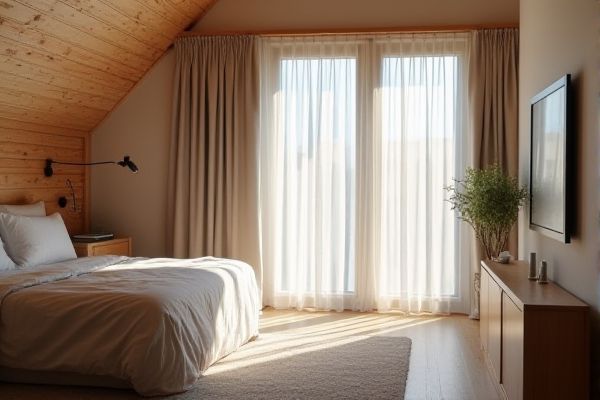
Attic partition curtains offer flexibility, light control, and easy installation, while sliding doors provide better sound insulation and a more permanent, stylish solution for dividing spaces. Discover the advantages of each option to decide which is best suited for your attic in the rest of this article.
Table of Comparison
| Feature | Attic Partition Curtain | Sliding Door |
|---|---|---|
| Installation | Easy, minimal tools | Requires professional fitting |
| Cost | Low-cost option | Higher initial investment |
| Space Efficiency | Does not occupy floor space | Saves space but requires track area |
| Privacy | Moderate, fabric-based | High, solid barrier |
| Sound Insulation | Low | Good |
| Light Control | Allows some light through fabric | Blocks light effectively |
| Durability | Less durable, wear over time | More durable, robust materials |
| Design & Style | Varied fabrics, flexible styles | Modern & sleek designs available |
| Maintenance | Easy to clean or replace | Requires regular track cleaning |
Introduction to Attic Space Division
Attic space division offers functional separation for storage, living, or workspace areas, enhancing usability and organization. Attic partition curtains provide flexible, lightweight separation with easy installation, allowing quick access and adjustable privacy. Sliding doors deliver durable, space-efficient division, optimizing insulation and sound control for more permanent attic room configurations.
Understanding Attic Partition Curtains
Attic partition curtains provide a flexible, cost-effective solution for dividing attic spaces without the permanence or expense of sliding doors. These curtains enhance insulation and privacy while allowing easy access and adaptability to varying attic layouts. Your choice between attic partition curtains and sliding doors depends on balancing convenience, aesthetic preferences, and space functionality.
What Are Sliding Doors for Attics?
Sliding doors for attics are space-saving entry solutions that glide horizontally along a track, offering easy access without the need for additional clearance. Unlike attic partition curtains, sliding doors provide better insulation, noise reduction, and durability, making them ideal for maintaining temperature control and privacy in your attic space. These doors often come in various materials and finishes, allowing customization to match your attic's aesthetic and functional requirements.
Aesthetics: Curtain vs Sliding Door Design
Attic partition curtains offer a soft, flexible aesthetic that can easily complement various interior styles with their range of fabrics and colors, creating a cozy and inviting atmosphere. Sliding doors provide a sleek, modern look with clean lines and materials like glass or wood, adding a sophisticated and structured element to your attic space. Your choice between the two should consider whether you prefer the warm, adaptable charm of curtains or the polished, space-saving design of sliding doors.
Installation Process Compared
Installing an attic partition curtain involves minimal hardware and can be mounted quickly using a tension rod or ceiling track system, making it a cost-effective and flexible solution. Sliding doors require precise measurements, track installation, and often professional assistance to ensure proper alignment and smooth operation, resulting in a longer, more complex installation process. Curtains offer easier customization and adjustment post-installation, while sliding doors provide a more permanent and durable partition with higher installation demands.
Space Efficiency and Flexibility
An attic partition curtain maximizes space efficiency by occupying minimal room when drawn, making it ideal for compact areas where every inch counts. Sliding doors provide flexibility with their ability to create defined, sound-insulated spaces, but require wall space for tracks, potentially limiting layout options. Your choice depends on whether you prioritize unobstructed spatial utilization or enhanced privacy and noise control.
Insulation and Privacy Factors
Attic partition curtains offer moderate insulation by reducing drafts but lack the airtight seal provided by sliding doors, making sliding doors more effective at maintaining consistent temperature control. Sliding doors enhance privacy by creating a solid barrier that blocks both sound and sight, whereas curtains provide only visual separation and limited sound reduction. For improved thermal insulation and superior privacy, sliding doors are the preferred choice in attic space division.
Cost Analysis: Curtains vs Sliding Doors
Attic partition curtains generally cost less than sliding doors, with average installation expenses ranging between $50 and $200, whereas sliding doors can cost from $300 to $1,500 depending on materials and track systems. Curtains offer a budget-friendly, flexible solution requiring minimal structural modification, while sliding doors demand more upfront investment for hardware, professional installation, and custom fitting. Your choice should weigh ongoing maintenance costs and aesthetic preferences against the initial financial outlay to determine the best value for your attic partition needs.
Maintenance and Durability
Attic partition curtains require minimal maintenance, needing only occasional washing or replacement, but may wear out faster due to fabric exposure and frequent movement. Sliding doors offer greater durability with sturdy materials like wood or metal, providing long-term reliability and protection, although they require periodic lubrication and track cleaning for smooth operation. Choosing sliding doors enhances durability and reduces maintenance frequency, while curtains offer easier upkeep but shorter lifespan.
Choosing the Right Option for Your Attic
Attic partition curtains offer flexible space division and easy installation, making them ideal for temporary or adjustable room separations. Sliding doors provide a more permanent, durable solution with better insulation and soundproofing, enhancing privacy in your attic. Your choice depends on whether you prioritize convenience and adaptability or long-term functionality and aesthetic appeal.
 homyna.com
homyna.com